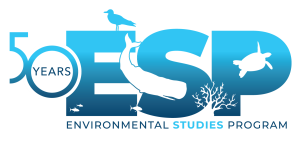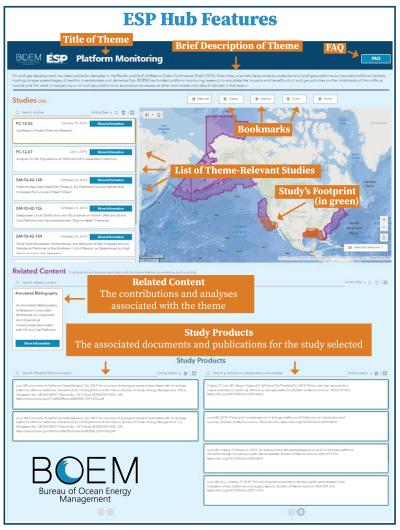BOEM’s Environmental Studies Program (ESP) develops, fund and manages rigorous scientific research specifically to inform policy decisions on energy and mineral resource development on the Outer Continental Shelf (OCS). ESP has provided more than $1.25 billion for research since its inception in 1973. Recently, BOEM launched a new online platform to disseminate research results from over 700 research projects conducted over the past 20 years.
The ESP Hub replaces the previous geoESPIS search tool, ushering in a new paradigm for scientific information discovery. It is designed to directly engage the general public with ESP scientists, BOEM technical analysts, and agency decision makers. To make this transition happen, BOEM gathered user requirements, rebuilt the
database, and redesigned the public-facing application to improve accessibility to ESP studies.
Searching by Research Theme
One of the keys to the ESP Hub’s improved interface is that users do not need advanced science knowledge to discover BOEM’s latest scientific literature or learn about science hot topics. The ESP Hub identifies and groups products into approximately 50 curated collections of BOEM’s scientific output—
called “research themes”— to make ESP’s scientific information more accessible to a broader, non-technical audience. The Hub summarizes each theme and incorporates pertinent ESP research projects, scientific reports, and peer-reviewed publications. End users navigate the ESP Hub by identifying with a research topic and clicking on a research theme (see sidebar).
The ESP Hub contains four broad thematic categories: Biological, Chemical, Physical, and Social Sciences. Some studies may fall into more than one category. For example, the, Marine Arctic Ecosystem Study (MARES), was an interdisciplinary research program. This award-winning environmental study can be found both under the biology research theme and the physics research theme.
How It Works
The ESP Hub’s research themes follow a templated mapping interface, much like a vending machine: a user selects a study, which triggers the theme template to dispense the corresponding study products, which can include BOEM final reports, technical summaries, journal articles, conference presentations, and any other related publications.
The simple user interface effectively and efficiently disseminates relevant research results while minimizing the level of detail end user have to sort through to access the research products. The template lowers barriers for entry to enable engagement all levels of users. Site visitors may learn something new using the interactive map, including the applicability of studies, research themes, and disciplines related to BOEM activities.
To see the theme selection process in action, watch this video: How to navigate the ESP Hub video
New Feature
However, discovery is only the first phase in the scientific process. Scientific analyses are an important next step in the scientific process. A new capability of the ESP Hub highlights how scientific information and data from studies were applied in analyses and information products developed to support the BOEM regulatory mission.
Sometimes the traceability of studies information and how it is reused is not always clear, and there has not been a suitable tool to document these linkages…until now.
Related content is a new concept introduced with the ESP Hub. This new feature gives a more holistic perspective on the purpose and benefits of BOEM’s research investments. It captures what information the BOEM analyst derived from the study products to support the research theme, and geographically references this contribution.
Take, for example, the “Beaufort and Chukchi Seas Mesoscale Meteorology Modeling Study,” a study to improve meteorological hindcast modeling of the Alaska Artic Ocean. The model output from this study was hosted to the Alaska Ocean Observing System and is highlighted with the Community Access to Weather Research related content, which emphasizes how environmental studies support BOEM’s physical models of the Alaska Arctic Ocean.
To be effective, ESP science requires an open and reliable outlet for technical analysis supporting BOEM decision making. With the ESP Hub, BOEM is making strides towards opening up all BOEM scientific and technical processes to improve BOEM engagement with stakeholders and transparency to the general public.
For More Information
This story is part of the “Unleashing the Science” series, showcasing how bureaus within the Department of the Interior produce and apply science to ensure responsible management decisions for our planet now and for the future.
--BOEM--
The Department of the Interior’s Bureau of Ocean Energy Management (BOEM) manages development of U.S. Outer Continental Shelf (OCS) energy, mineral, and geological resources in an environmentally and economically responsible way.




